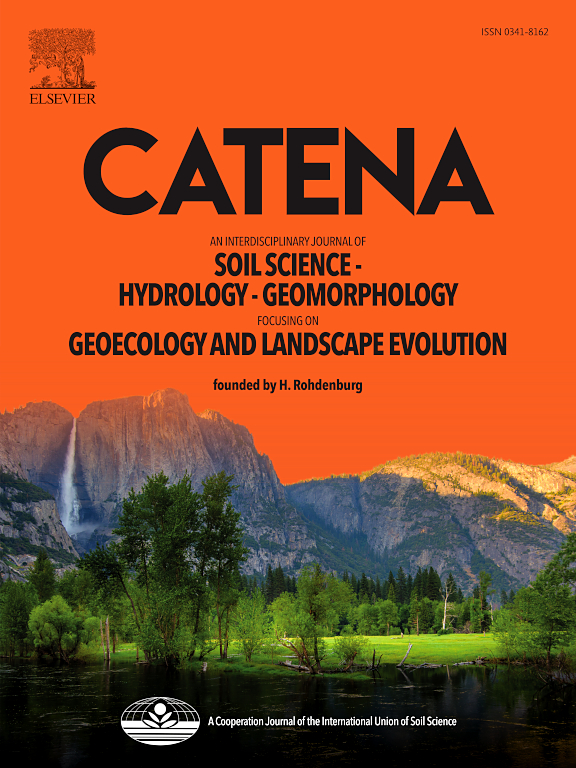沟槽侵蚀过程中灌木茎干和凋落物促进水流集中分支、增加水流阻力和减少泥沙的作用
IF 5.7
1区 农林科学
Q1 GEOSCIENCES, MULTIDISCIPLINARY
引用次数: 0
摘要
植被在控制沟蚀中起着关键作用。然而,很少有研究阐明灌木及其组分通过改变水流水力学和土壤流失对沟床侵蚀过程的影响。本研究通过一系列原位冲刷试验,研究了灌丛茎干和凋落物对沟床侵蚀过程中集中流道特征、水力特性和产沙量的影响。以典型灌木Leucaena leucocephala为研究对象,设置5种茎盖度(0%、0.15%、0.30%、0.60%和1.20%)和5种凋落量(0、100、200、300和400 g m−2)。采用4种不同处理:茎和枯枝(SL)、茎和枯枝(OS)、枯枝(OL)和对照裸沟床(BG)。结果表明,与裸沟床相比,各处理均显著增强了集中流分支,增大了达西-韦斯巴赫摩擦系数(f),降低了流量、流速、剪应力和土壤流失率。SL处理对径流和侵蚀的综合效应最强。阀杆在降低流速和剪切应力方面最有效,平均分别贡献21.23%和7.54%。凋落物主要增加了流动阻力f,降低了流量和土壤流失率,平均贡献率分别为123.59%、20.60%和27.67%。增加茎盖度和凋落物量可以增加其对径流和侵蚀的控制作用。当凋落物数量超过200 g m−2时,凋落物逐渐取代茎干,在增加沟床上的流动阻力和减少集中流动和侵蚀方面发挥主导作用。这些发现加强了对灌木及其组分如何控制沟壑发育的理解,并强调了保持沟壑床凋落物对减轻沟壑侵蚀的重要性。本文章由计算机程序翻译,如有差异,请以英文原文为准。
Effects of shrub stem and litter on promoting concentrated flow branching, increasing flow resistance, and reducing sediment during gully bed erosion
Vegetation plays a critical role in controlling gully erosion. However, few studies have clarified the effects of shrub and its components on gully bed erosion processes by altering the flow hydraulics and soil loss. In this study, a series of in situ scouring experiments were conducted to investigate the influence of shrub stem and litter on the concentrated flow pathway characteristics, hydraulic properties, and sediment yield during gully bed erosion. The experiments involved a typical shrub named Leucaena leucocephala, with five stem coverage (0 %, 0.15 %, 0.30 %, 0.60 %, and 1.20 %) and five litter amounts (0, 100, 200, 300, and 400 g m−2). Four different treatments were applied: stem and litter (SL), stem only (OS), litter only (OL), and a control bare gully bed (BG). The results showed that, compared to the bare gully bed, the various treatments significantly enhanced concentrated flow branching, increased Darcy–Weisbach friction factor (f), and reduced flow rate, velocity, shear stress, and soil loss rate. The combined effect produced by SL treatment on runoff and erosion was the strongest. Stems were most effective in reducing flow velocity and shear stress, contributing an average of 21.23 % and 7.54 %, respectively. Litter primarily increased the flow resistance f and reduced flow rate and soil loss rate, with average contributions of 123.59 %, 20.60 %, and 27.67 %, respectively. Increasing stem coverage and litter amount increased their contribution of controlling runoff and erosion. When the litter amount exceeded 200 g m−2, it gradually replaced stems as the dominant role in increasing flow resistance f and reducing concentrated flow and erosion in the both stems and litter covered gully beds. These findings enhance the understanding of how shrub and its components control gully development and highlight the importance of maintaining litter in the gully beds to mitigate gully erosion.
求助全文
通过发布文献求助,成功后即可免费获取论文全文。
去求助
来源期刊

Catena
环境科学-地球科学综合
CiteScore
10.50
自引率
9.70%
发文量
816
审稿时长
54 days
期刊介绍:
Catena publishes papers describing original field and laboratory investigations and reviews on geoecology and landscape evolution with emphasis on interdisciplinary aspects of soil science, hydrology and geomorphology. It aims to disseminate new knowledge and foster better understanding of the physical environment, of evolutionary sequences that have resulted in past and current landscapes, and of the natural processes that are likely to determine the fate of our terrestrial environment.
Papers within any one of the above topics are welcome provided they are of sufficiently wide interest and relevance.
 求助内容:
求助内容: 应助结果提醒方式:
应助结果提醒方式:


